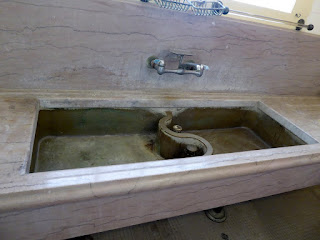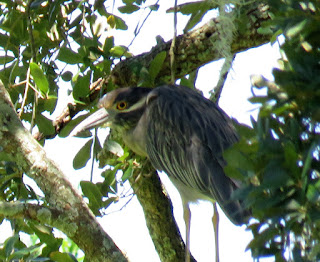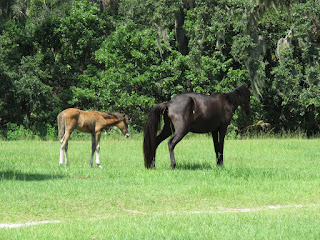Our last day we took the ferry to Cumberland Island which is
a National Park. Whoo Hoo, our first National Park since I got my Senior Pass.
It’s the largest and southernmost barrier island of Georgia.
Natives, missionaries, enslaved African Americans and Wealthy Industrialists
all walked here. It has protected
beaches, maritime forest and salt marshes. The Dungeness Ruins are the remains
of a mansion built by Thomas Carnegie, brother and partner of steel tycoon
Andrew Carnegie. Georgian Revival–style Plum Orchard is another Carnegie
estate. The simple, 1-room First African Baptist Church lies north. Wildlife
includes loggerhead turtles and feral horses.
ferry to the island
sights on the ferry ride there
wake of the ferry
Ibis
Osprey
Bald Eagle
We signed up to take the Lands & Legacies tour which was
about 6 hours and it covered the entire island and Mike was an excellent guide.
He really made the island “come alive” with his commentary. I had no idea of
the history of the island (other than that’s where John F. Kennedy Jr &
Carolyn Bessette got married.) There is no food or drink on the island, so we
came prepared with a picnic lunch and lots of drinks….it has been HOT here. We
were thankful for the wonderful A/C in Mike’s van and when we made stops he
left it running so when we got back in it was cool.
arrival on the island
Mike, our guide
feral horses in the tall grass
Stafford Cemetery surrounded by a tabby wall
Thomas Hutchinson & mother and sister
Thomas Hutchinson
Robert Stafford (famous golfer from Scotland)
American Redstart
used to be a golf course - now the Stafford airstrip
Stafford House
used to be cotton fields
The privileged have sought refuge on Cumberland Island for
more than 100 years. Throughout the last century, the island's pristine forest
of moss-draped oaks has been home to Pittsburgh's Carnegies and New York's
Rockefellers and Atlanta's Candlers (founded Coca-Cola).
The island is mostly National Park with some private land
and while some of the original buildings/ruins are still there it was hard to
picture the island being such a vibrant high society place. The privileged
never worked and were there just to have fun. So, Lucy Carnegie (Miss Lucy)
created a huge resort with pools, tennis courts, golf, hunting and fishing
mainly for all of her children who all had homes there as well. The 19th
Century’s Gilded Age & the Industrial Revolution created an explosion of
wealth.
We saw where there used to be cotton fields and learned that
Eli Whitney invented the cotton gin with the help of the wealthy on the island
that funded his invention. (sadly, he didn’t patent it and others improved on
his design and they made the most money from the cotton gin) Edison built an electricity
plant so the mansions had electricity. They had running water and flushing toilets.
(a real luxury in those days)
Plum Orchard is an estate located in the middle of the
western shore of Cumberland Island. The estate and surrounding area are listed
on the National Register of Historic Places. It is a 4 story tabby home with
one side for the family and the other side for the servants. We got to tour the
home which took about an hour. We saw a ton of feral horses that had been left
behind by the Spaniards and had our lunch on the grounds of the Plum Orchard
Estate. We sat on the swing on the porch while we ate and watched the wild
turkeys and feral horses.
Plum Orchard Mansion
feral horses on the property
back of Plum Orchard Mansion
the entry hall
wallpaper in the entry of Carnegie family crest
the women's room
silk water lilies wallpaper
Tiffany lamps
hallway to the men's room
tortoise shell lamp
taxidermy
upstairs
main hallway
her closet
feinting couch
her bathroom
the lower faucet dispenses shampoo
bidet
her bedroom
his closet
his bathroom
every bedroom had it's own bath
child's room
linen closet
wine & alcohol
the other half of the house was for the servants - kitchen
this was the plating room
pharmacy
the basement housed the electrical and storage
her original sink and commode stored here as they were too valuable to leave in the display
we had lunch on the porch the indoor swimming pool was just inside
pond in the back with Ibis rookery
Night Heron
John F. Kennedy Jr. is only the latest member of that elite
class to come here seeking seclusion. And the island's historic devotion to
protecting the privacy of those who wish not to be seen enabled Mr. Kennedy to
marry Carolyn Bessette on Saturday without intrusion by the paparazzi, who are
paid to expose his life. They were married in the humble First African Baptist
Church.
First African Baptist Church, founded in 1893 on the northern
end of the island in a community settled by former slaves. But he said that
things may change now for the small inactive church, which holds 11 weathered
pews and has a cross made of sticks tied together with string at the altar. The
church doubled as a school. Miss Lucy insisted that the slaves got an
education. They were paid a fair wage and were not beaten. They were encouraged
to save and manage their money. (which came in handy for them when slavery
ended and they had money to buy their own land and had an education to get
better jobs)
we stopped at a lookout
First African Baptist Church
it doubled as a school
inside the church
we stood where John F. Kennedy Jr & Carolyn Bessette did
this is one of the slave's homes (propped up)
"crazy lady" that lives on the island (check out her website Wildcumbereland.org)
Ibis & Roseate Spoonbills scatter
We had enough time to see the other part of the island which
has the Dungeness Ruins. In the 1880’s the huge mansion was purchased by Thomas
M. Carnegie, brother of Andrew Carnegie, who began to build a new mansion on
the site. The 59-room Queen Anne style mansion and grounds were completed after
Carnegie's death in 1886. His wife Lucy continued to live at Dungeness and
built other estates for her children, including Greyfield for Margaret
Carnegie, Plum Orchard for George Lauder Carnegie, and Stafford Plantation. By
this time, the Carnegies owned 90% of the island.
our first glimpse of Dungeness through the windshield
turkeys & feral horses
the Pergola
other buildings around the estate
Northern Parula
skink
It was a very enjoyable day and we were glad we took the
tour as we learned so much about the island. (and enjoyed the A/C)
We honestly could have stayed another day or 2 in St.
Mary’s. It turned out to be a lovely town to visit.
Tomorrow, we leave for Savannah. Our first choice for our
stay in Savannah was only available for 3 of the 6 days we wanted so we went
with another choice. Actually, our second choice had no availability until
October. Oh, the car going dead was operator error. Two different sources had
exact opposite instructions for “DOT on” vs. “DOT off”. Don’t have a clue what
that means, but glad we got it worked out.































































































































































Sounds like an excellent tour, felt like I was almost there. I will have to make it a point to visit that location if we are nearby. That was very interesting. Thanks.
ReplyDelete